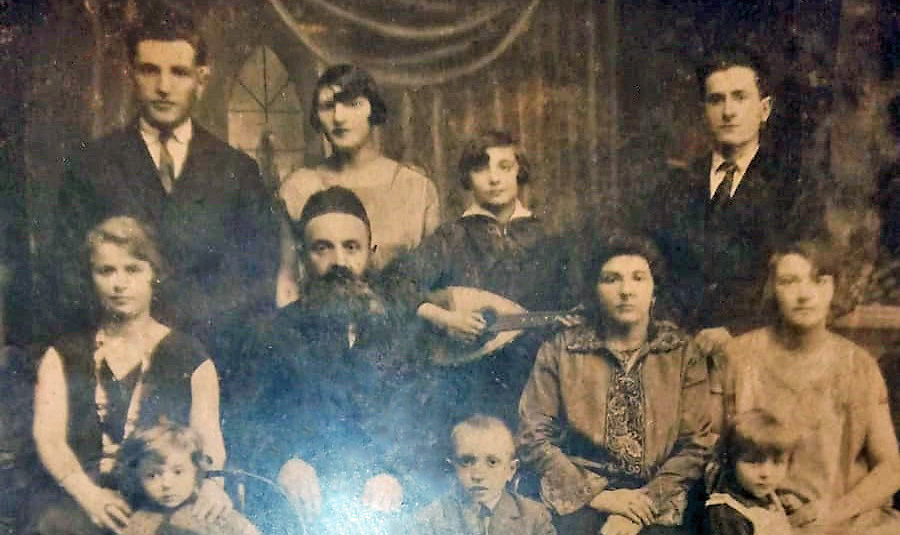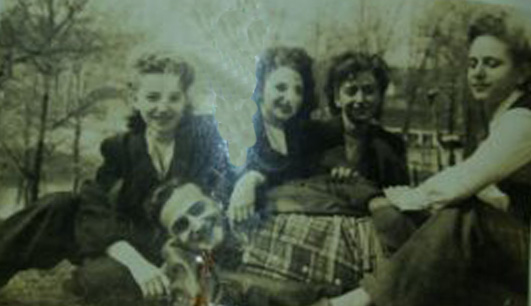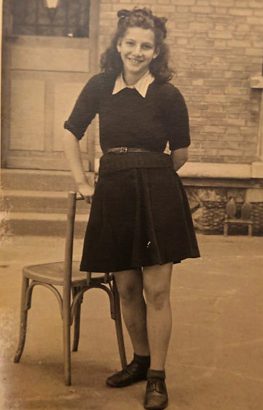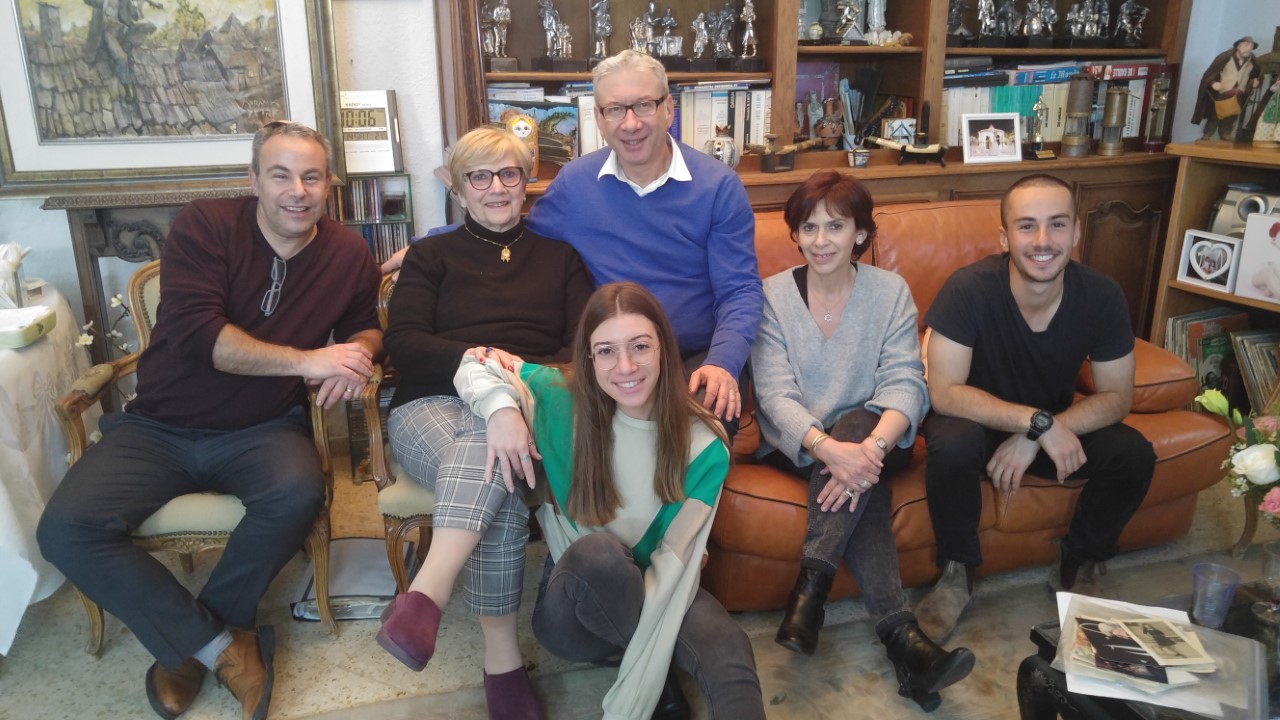By Rashi Rosenzweig
It’s a picture of a young Parisian girl who is roughly 12 or 13 years old. She is standing by a chair in a schoolyard, wearing a nice dress. She has a lovely smile, light olive complexion, and thick just below the shoulder length brown, curly hair. On the back is a note written in beautiful handwriting, Paulette at school. Sends you her fondest regards. June 1947. Aside from the fact that I know that she is a relative of my mother’s, I’ve had no other information about her at all whatsoever.
Paris, France, was home to many Jews of Polish extraction, especially post-WWI. Before the Jews of Northern Africa made up the majority of the Jews of France that we know today, before WWII Yiddish was the common language spoken by Jews throughout France, many of whose families lived there for centuries. After WWI when my grandmother, uncle, aunt, and great-grandmother were immigrating to New York to meet up with my grandfather, they stayed in Paris with my great-uncle Charles and his wife Terese, along with their children Bernard and Jean. After roughly one year, my grandmother and her family, including her mother, set sail for Ellis Island in America, settling in with my grandfather and his relatives on New York’s famous Lower East Side, building a family totaling 10 children, most of whom now boast grandchildren and great-grandchildren. Back in those days, when one left family behind in another country, unless they were devoted letter writers, they never had contact with their relatives again.
Before and after WWII broke out, my aunt Sara was in regular contact with her relatives in France and in Lublin, Poland. However, there was a point in time where she never heard from them again. They figured that if they survived, they would contact the family. Yet, with the exception of my great-uncle and his family, this never happened, so my grandmother and aunt assumed the worst. My grandmother was an infirm woman by the mid-1940s. She was widowed young and left with 10 children, eight of whom lived at home. The horrific thought of what may have happened to her sister and her extended family was just too much for her to bear. Thankfully, however, her brother Charles and his immediate family survived. My mother, who worked full time from an early age, and her sister were able to fly to France to visit this family around 1953, two years after my grandmother passed away.
Fast forward to my childhood. Being that I was born to be a genealogist, I was the one in the family who loved to immerse myself into old family albums and pictures. I couldn’t get enough of them. One picture, in particular, was the one I described above. My mother never said much about it. All I knew was that her name was Paulette. That was that.

(front row, 2nd from right); her
husband Meir (3rd from right)
and Family
(click to enlarge image)
Fast forward once again to 3 January 2019. No longer a child, I boast 51 years, but people tend to mistake me for younger and I’m perfectly OK with that. I was doing some random genealogy research on JewishGen’s website, which I had been told had many updates and had added more information. To cut a long story short, on JewishGen’s All Poland Database, I found the name of a woman who was a daughter of my great-grandparents. It was Etla Kroghszlengel. Never in my life had I ever heard of this woman.
After some detective work, I found Etla’s name on the same family tree site that I use. After even more detective work, I found one Paulette Lapidus, the wife of the man who started that family tree. Luckily she was on Facebook and I found that she was living in Netanya, Israel. Being adventurous, I found her number via Bezeq (the Israel Phone Company) and dialed. A woman with a very thick French accent answered. I asked her in Hebrew if I could continue to speak with her in Hebrew. She asked if I spoke English and of course I said, yes. I introduced myself and stated that I was a genealogist researching the name Krouchtein or Kroghszlengel. She said that she had a grandmother named Etla Krouchtein (the name had been shortened to Krouchtein from Kroghszlengel when they emigrated to Paris) who was from Lublin, yet moved to France.
I then felt my entire body shake and told her that Etla was my grandmother’s sister. “Sacre coure,” she responded. I told her that I always knew of my great-uncle and his family and that they all survived the war, yet I never in my life ever heard of an Etla Krouchtein. She informed me that her father, Avraham Klik, was a son of Etla (Krouchtein) Klik. She then told me that she remembered when she was a teenager, two girls in their twenties came to visit from New York. She remembered that they stayed for a while, as well as with my great-uncle. I blurted out, “You know my mother! (of course I started crying). You met my mother and my aunt!” Chuckling, she responded warmly, “I guess I did. Yes.” I asked her if she remembered Marilyn Feigenbaum, and she said, “Not really.” Then I asked her if she remembered Toby Feigenbaum, and she responded, “Ahh yes. Toby. I remember a Toby.”
Paulette continued to state that she, too, has had pictures for many years and wished that I would identify them. As a lover of old family photos, how could I say no?
Then, the penny dropped.
Paulette at school. Sends you her fondest regards. June 1947. “Paulette, I think I may have a picture of you,” I said after that epiphany. As I was speaking to her, I was rummaging through old photos until I finally found it. I sent it to her via WhatsApp. She responded, “It is me. We will meet soon.”
She then sent me the pictures that she was talking about. The one that had me crying non-stop was one of my mother, three of her sisters, and her brother, taken in The Bronx between 1945 and 1946. Additionally, Paulette sent me pictures of my grandmother with my uncle who was in a Navy uniform, another uncle with my aunt and two of my cousins, as well as pictures of my French cousin, who I knew, as well as his parents. Two pictures however I cannot identify, and I have a feeling that they are relatives who more than likely perished at the Belzec Death Camp like many others from Kamorow in Lublin.

Rosenzweig (far right)
and Siblings
The Bronx, New York; c. 1946
(click to enlarge image)
We met Saturday night after Shabbat on 12 January 2019 at Paulette’s lovely home in Netanya. It is a large penthouse apartment overlooking the Mediterranean Sea just across the street from the shore. Paulette answered the door with her son Lionel and her daughter Sandrine on either side of her. They were warm and excited when the door opened. My wife and I were both welcomed with hugs and kisses on each side of our faces. We were greeted by Lionel’s wife Patricia and Sandrine’s husband Yves Cohen-Solal, who were waiting in the salon. There was a huge generous spread of cheeses, wine and sandwiches. It was, for lack of better words, very beautiful and very French. She had even more pictures of my family that I never saw before, including a picture of my aunt Dorothy and Uncle Louis when they were first engaged, and that of an old, religious man, who most likely was my great-grandfather.
Lionel’s younger daughter Sarah met up with us later as well as one of my younger sons Motti. It was so wonderful to have these next generations meet. We will, GD willing, meet up with the rest of our families in the near future.
Two yellow Stars of David with the word “Juif” are taped to the middle of Paulette’s bureau. She told me that these were patched to her clothes when she was a young girl in Nazi occupied France. She, her mother Rivka, and her sister Chana were constantly on the run and fortunately they were never caught. Despite several very close calls, they managed to escape the clutches of the Nazis.
Paulette’s father, my mother’s first cousin, Wolf Avraham Klik, was not as lucky. He was arrested early on in the war and incarcerated in a forced labor camp. It was the type of situation where her family was allowed to visit with him from time to time and he was even permitted to stay with them in their hotel. Avraham Klik had many opportunities to escape, yet if he did, the authorities would arrest his wife and their children. So, as a result, Avraham Klik played closely by the rules. However, when the Nazis began rounding Jews up in the summer of 1942, Jews who were in forced labor camps, including Avraham Klik, were deported immediately to Auschwitz. Needless to say, Rivka Klik and her daughters had no way to be in contact with him.
Despite the fact that they had very little money, very little food, and had to depend upon the kindness of Gentile friends or strangers to hide them, they were very fortunate. In mid-1945, after Germany surrendered, Chana Klik, Paulette’s older sister, would travel to the main post office in Paris where lists and pictures of survivors were displayed. Chana carried a picture of her father. One day at the post office, a man approached Chana and told her that he recognized the man in the photo. He confirmed that it was Avraham Klik and he knew him at Auschwitz. He informed her that he was a part of a band of young men who managed to escape the infamous death camp, yet they were caught by the SS in the forests not too far from that hell hole. He along with his comrades were shot and killed on the spot.
Sharing family history, sharing laughs, and creating an atmosphere of familiarity that is only found at family gatherings, I was able to forge relationships with people who just over one week before this were total strangers. Since then, I added many names to my family tree and was introduced to an entire branch of my grandmother’s family who I never really knew existed.
This may be a closed chapter that is roughly 70 years old, but a new chapter is beginning, and it began that one Thursday morning in early January 2019 when I randomly logged onto the JewishGen website just to see what was new.
February 2019
Ra’anana, Israel
Editor’s Research Notes and Hints
Rashi discovered the name of a previously unknown great-aunt Etla on JewishGen’s All Poland Database, which includes records from Jewish Records Indexing – Poland.
Rashi then found Etla listed on an online family tree and Etla’s granddaughter Paulette after more digging. He was creative in searching for Paulette, finding her on Facebook, and then locating her telephone number through Bezeq , the Israeli phone company’s directory.
Rashi acknowledges the guidance he has received from Trisha Wilson, Genealogist, Ra’anana, Israel.

